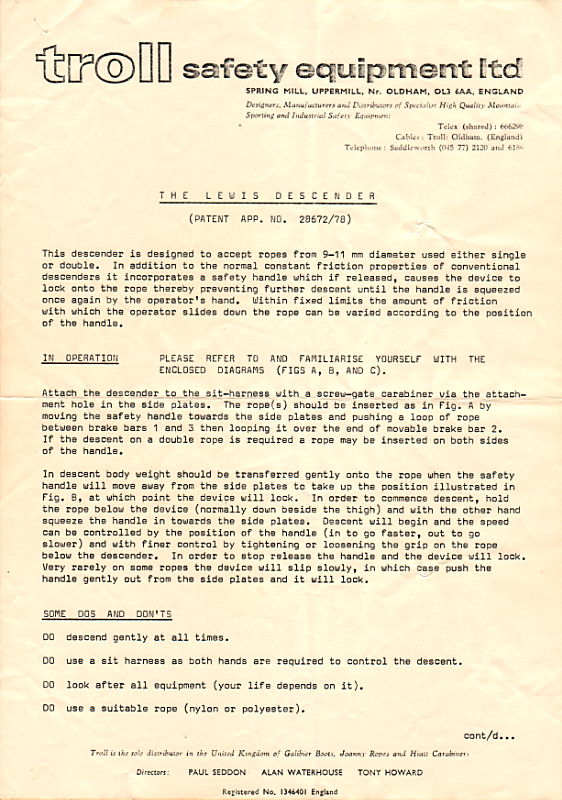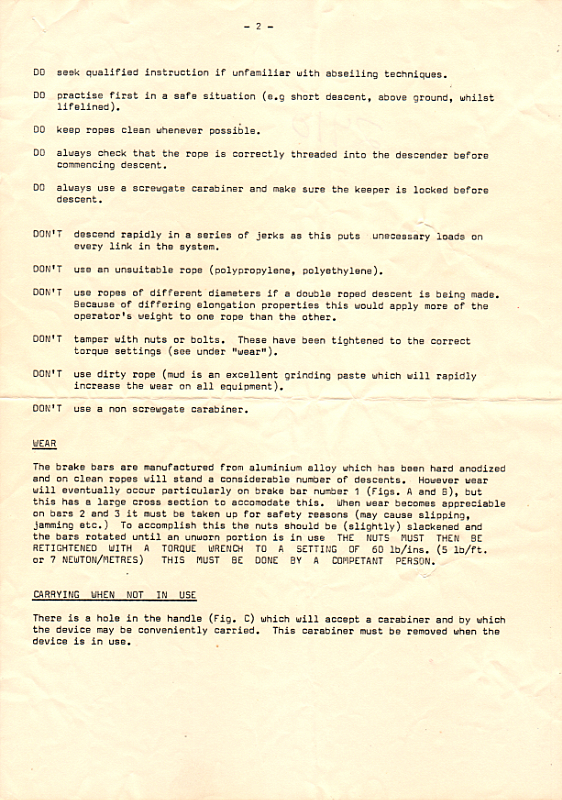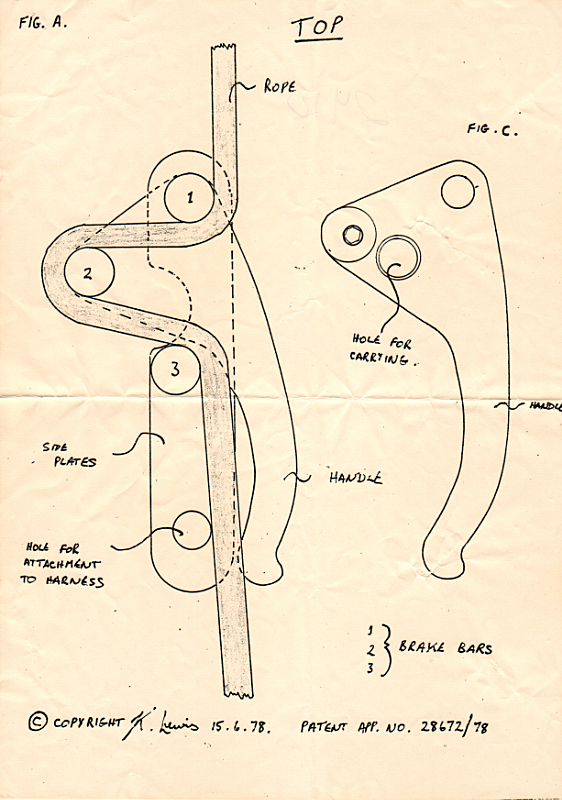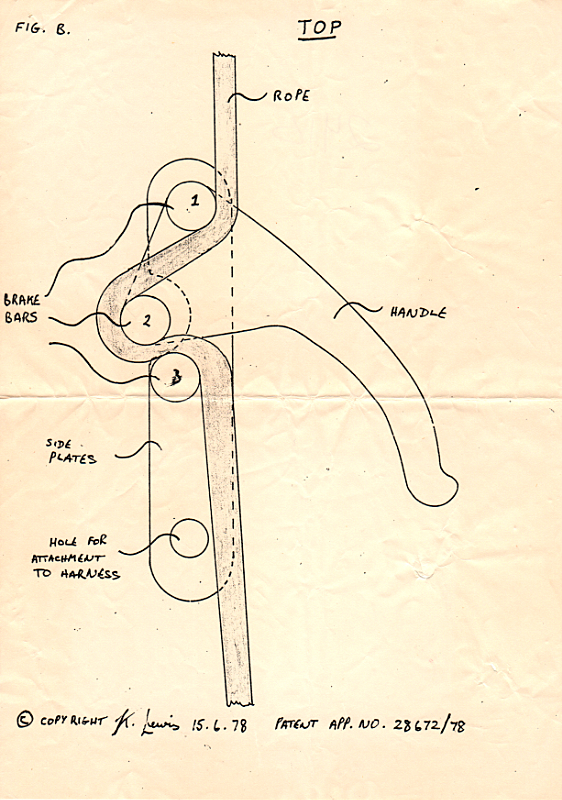Overview
[ Top
| Version B
| Return to PolyBollards
]
Version A
(#1332)
Technical Details
I acquired my Lewis, Version A from John Marshall in 2012.
My Lewis, Version A is 187 mm. tall, 74 mm. wide, 79 mm. thick, and weighs 305 g.
Version A is identical to Version B except that the side plates and rollers are not anodized.
The left side plate is stamped with "LEWIS" and the right with "PAT.APP.No" and "28672/78." Each bolt head has "M," "A2," and "NS" in raised letters.
The Lewis is a British descender.
[ Top
| Version A
| Return to PolyBollards
]
Version B
(#463, 2410)
Technical Details
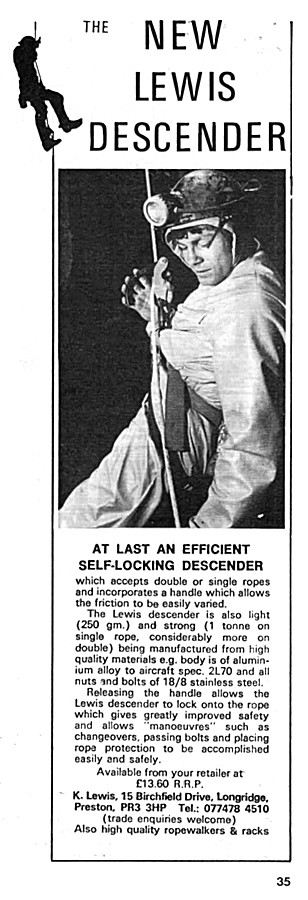 Keith Lewis first advertised his Lewis Descender in the July 1979 issue of Descent magazine. I acquired my Lewis, Version B from Speleoshoppe in December 1979. I acquired another in 2017 as part of Bob Thrun’s collection.
Keith Lewis first advertised his Lewis Descender in the July 1979 issue of Descent magazine. I acquired my Lewis, Version B from Speleoshoppe in December 1979. I acquired another in 2017 as part of Bob Thrun’s collection.
My Lewis, Version B is 190 mm. tall, 71 mm. wide, 80 mm. thick, and weighs 308 g.
The Lewis descender is a double-rope device. Except for the
bolts and nuts, it is bilaterally symmetrical.
The Lewis Descender consists of two fixed bollards mounted
between fixed aluminum side plates, and a moving bollard mounted
on a lever pivoting from the upper bollard. The side plates are
3.5 mm. anodized aluminum. The side plates are
drilled to receive the bollard mounting bolts, and have a 13 mm
attachment hole drilled at the bottom. The attachment holes on
the two plates are about 1.2 mm. out of line with each other. A
large, rounded notch in each side plate provides clearance for
the moving bollard.
The top fixed bollard is 25.5 mm. in diameter It is split into
two with the lever pivoting between the two halves. Each half
is 15 mm. long, limiting the device to ropes smaller than this.
The lower fixed bollard is 19 mm. in diameter and 33 mm. long.
The moving bollard is in two pieces, each 19.4 mm. in diameter
and 31.3 mm. long, and bolted on each side of a 5 mm. subtriangular
aluminum plate. There is a beveled 13 mm. hole in the plate, and
a handle made out of 12 mm. tubing is riveted to the plate. Depressing
the handle pivots the moving bollard away from the fixed bollards,
reducing friction.
The left side plate is stamped with "PAT.APP.No" and "28672/78." The right side plate is stamped with " "LEWIS." The head of the top bolt has a raised "M," the head of the lower bolt has "INKOBA" and "A_2," and the head of the bolt holding the moving bollard has "M," "A4," a logo, and "88."
The Lewis descender can be used on single or double rope. A
bight is taken in each rope, and pushed through the device from
the lever side, and looped over the moving bollard. If you did
the math, you’ll recognize that the moving bollard extends about
14 mm. beyond the side plates, so the rope does not tend to come
off accidentally.
I have vivid memories of this being the worst device in my
collection, but the conditions I used it under (Goldline in a
rainstorm) were perhaps not a fair test. Still, I don't like this
descender because I feel that it is too sensitive. Under the conditions
just mentioned, a 5 mm. movement at the tip of the handle made
the difference between solidly stopped and near free-fall. On
drier kernmantle ropes, it might perform better.
The offset eyes are not intentional, and make for a tight fit
for some carabiners (in fact, some modern carabiners won't fit
at all). Use a maillon instead, they’re safer anyhow.
[ Top
| Version A
| Version B
]




